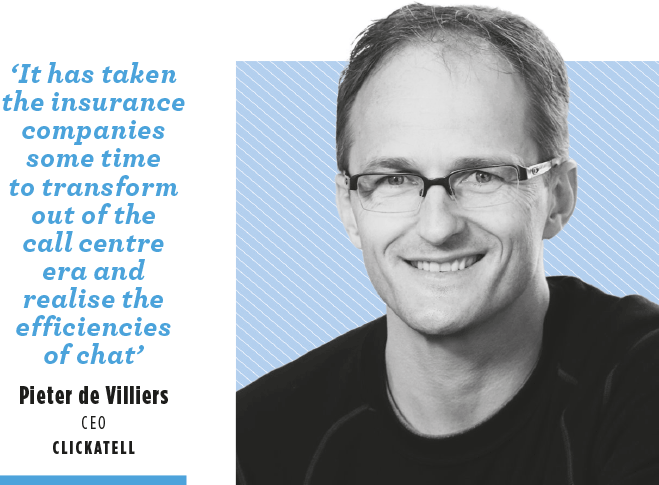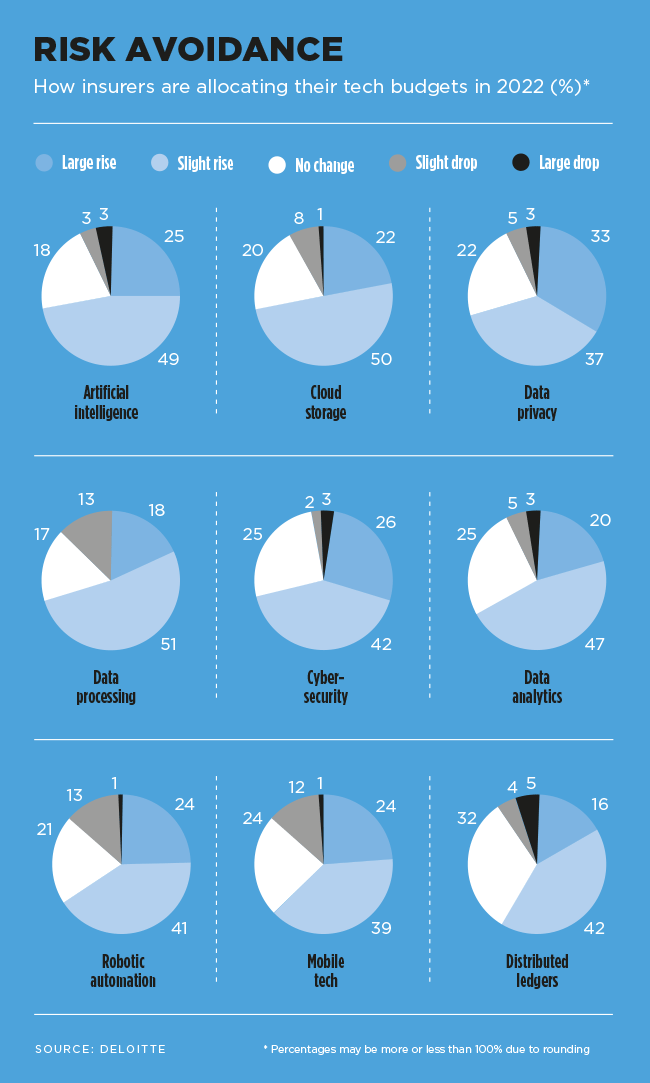Want a snapshot of the biggest risks in the modern world? Ask your insurance company. Cyberattacks, climate change, digital transformation, COVID-19… While those headline-grabbers are giving consumers and business leaders sleepless nights, they’re also sending shockwaves through the insurance industry.
KPMG’s South African Insurance Industry survey 2021 provides exactly that barometer. ‘A key theme has emerged overall,’ according to Mark Danckwerts, KPMG partner and Africa insurance practice leader. ‘With the fast pace of change in the interconnected world we live in today, we can place less reliance on past data to predict future outcomes. It is time to put a spotlight on the events we call “one-in-200-year events” with a vision of what the future might look like, and how this might differ from our limited understanding of historic events.’
In other words, the world of 2019 is very different from the world of 2022. The pandemic – together with extreme and unpredictable weather events and far-reaching digital disruptions – has reshaped our reality. Danckwerts notes that the KMPG survey showed that ‘all insurers had included COVID-19 in their forecasting’; that ‘insurers need to remain vigilant and keep on improving their modelling of extreme events’; and that ‘insurers will continue prioritising digital transformation for customers and intermediaries’.
The events of the past three years have had a tremendous impact on both long- and short-term life insurers’ balance sheets. The increase in life-insurance claims related to pandemic deaths was soon coupled with spikes in claims related to cyberattacks, unrest in KwaZulu-Natal in mid-2021, and disastrous flooding in the same province in early 2022. Add rapidly changing market demands to that, and you have an industry that’s having to think and react, and innovate more than ever.
So, Danckwerts asks, is the insurance industry out of the woods, post-pandemic? ‘Nearly,’ he says. ‘There is still some ground to cover, but it is good to see that insurers are adapting faster and becoming more agile.’

They have to. The African insurance sector is worth more than $68 billion in annual gross written premiums, with SA alone making up 70% (more than $47 billion) of that market. But the pandemic has changed the way South Africans want to consume insurance products. Bradley du Chenne, CEO of Hippo.co.za, says that the online insurance quote-comparison platform is seeing its biggest user growth in the 18- to 24-year-old age group. ‘This is due to these consumers being digital natives and feeling comfortable comparing financial products online, rather than through traditional channels,’ he says.
Yet it’s not just tech-native millennials; older consumers are also shopping online for their insurance products. ‘People in the 45- to 64-year-old age group are using our platform more now than they were before the pandemic,’ says Du Chenne. ‘The COVID period forced people online, and things like online grocery-delivery services became common. This has resulted in consumers becoming more comfortable comparing financial products online, too.’
He adds that Hippo.co.za – which is entirely online – has seen an uptick in digital-only insurance companies signing up for the platform. ‘We’ve partnered with digital brands such as Pineapple, Simply Insurance, One Spark, Zazu Life, MetGetUp, Stangen Life, Different Life…,’ he says. ‘And we’re always looking to add more as consumers move towards a preference for end-to-end online offerings.’
That trend is reflected in the funding space too. In August 2021, insurtech platform Naked raised $11 million in a Naspers-led funding round. Just two weeks before, Naspers (via its early-stage tech investment vehicle Naspers Foundry) had invested $2.3 million in another insurtech platform, Ctrl.
However, while consumers are ready to move to digital insurers, where are the traditional, brick-and-mortar players? It varies. During his keynote address at Clickatell’s African insurance cluster webinar in March 2021, Mark Walker, IDC associate VP for sub-Saharan Africa, pointed to the IDC’s 2020 MEA CIO survey, which found that 64% of the region’s insurance organisations were stuck in the early and middle stages of digital transformation. The survey found that just 11% of insurers were aggressively using new digital technologies.
Clickatell CEO Pieter de Villiers underlined this point, using digital chatbots as an example. ‘The insurance industry has a lot of catching up to do,’ he told the webinar. ‘Customers have expectations of how they want to engage with all of their brands, including the more traditional insurance companies.
‘In 2017, when the chat economy emerged, we saw banking leapfrog into the new era, but it has taken the insurance companies some time to transform out of the call centre era and realise the efficiencies of chat.’
Kreegan Govindsamy, head of product management at Discovery Holdings, shared how Discovery was enjoying the benefits of chat. ‘We now have the ability to offer interactive messaging, which has use cases across the entire customer journey,’ he said. ‘All the way from lead generation to sales, onboarding engagement and, if needs be, credit control and conservations. I think the use cases are becoming more widely adopted as a means to support and enhance human-based interactions.’
From online aggregators such as Hippo.co.za to AI-powered chatbots, digital technologies are helping insurers reach new markets while solving South Africans’ insurance needs. And while much of the innovation is being driven by those agile insurtech start-ups, larger providers are also harnessing the IoT to create better customer solutions.
‘From potentially infinite new sources of data to immutable data enabled by blockchain, and even the gamification of insurance through wearables, IoT is changing the game for insurers,’ says Harkrishan Singh, director of application development at AlphaCodes. ‘When data can be collected, centralised and analysed via machine learning, there is no end to the insight that can be gained.’
He says that IoT devices can help insurers in several areas, for example by tracking real-time data related to cargo, vehicles and personal health. ‘Anomalies can be flagged immediately for action, to prevent theft, address risky behaviour or alert people to potential health problems,’ he explains. ‘Commercial and residential real-estate insurance companies can leverage smart home devices, HVAC monitoring, IoT-enabled sensors and thermostats to manage fire and safety or property damages. In the medical space, fitness trackers, ECG monitors, pulse oxygen monitors and blood pressure monitors can be used to collect data and alert to potential health problems. In the automobile industry, telematics devices or onboard diagnostic – OBD-II – dongles can be used to monitor vehicle health and also driving behaviour.’ So the list goes on.
The point, says Singh, is that technology underpins many applications for the broader insurance sector, and that collected data can be used to more accurately calculate risk and investigate claims. This not only helps insurers to more effectively determine appropriate premiums; it also improves safety and helps in reducing the amount of fraud.
‘One of the key takeaways is that IoT devices provide data that can be analysed for improved insight,’ he says.
‘This means that premiums can be tailored more precisely to individual clients, rather than using a blanket approach to risk. IoT is disrupting the traditional insurance business model, and the pandemic has brought the benefits of this to the fore.’
According to Singh, ‘insurers need to embrace these technologies and use them as points of differentiation, helping them to attract and retain customers in a highly competitive market’.
From the customer’s side, digital technologies are helping consumers to compare and choose the best-value insurance cover for their needs, while also protecting them from insurers that might reject their claims based on technicalities or lack of evidence. After all, if your every move and every heartbeat is tracked and monitored by your insurer, it gives the industry ombudsman plenty of evidence to work with. (And in SA, insurance ombuds have been particularly busy recently. The Ombudsman for Long-Term Insurance and the Ombudsman for Short-Term Insurance reported in April that they’d recovered close to R400 million for consumers who had lodged disputes with the entities in 2021.)
KPMG’s South African Insurance Industry survey sums up the state of the sector from both sides. ‘The insurance industry is highly competitive. To stay relevant, insurers must embrace digitalisation to ensure they can continue to serve their customers’ needs in an efficient and simplified manner, and grow the customer base to achieve economies of scale in an environment of increasing costs.’









